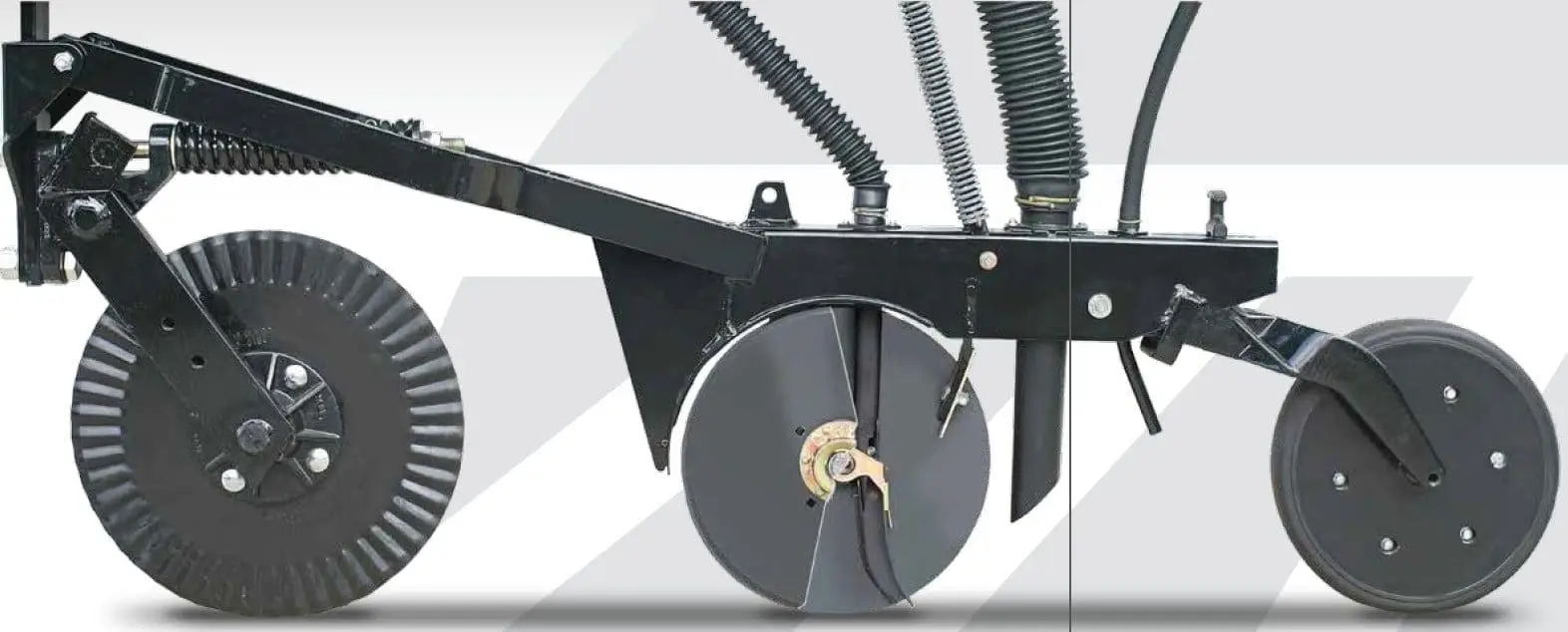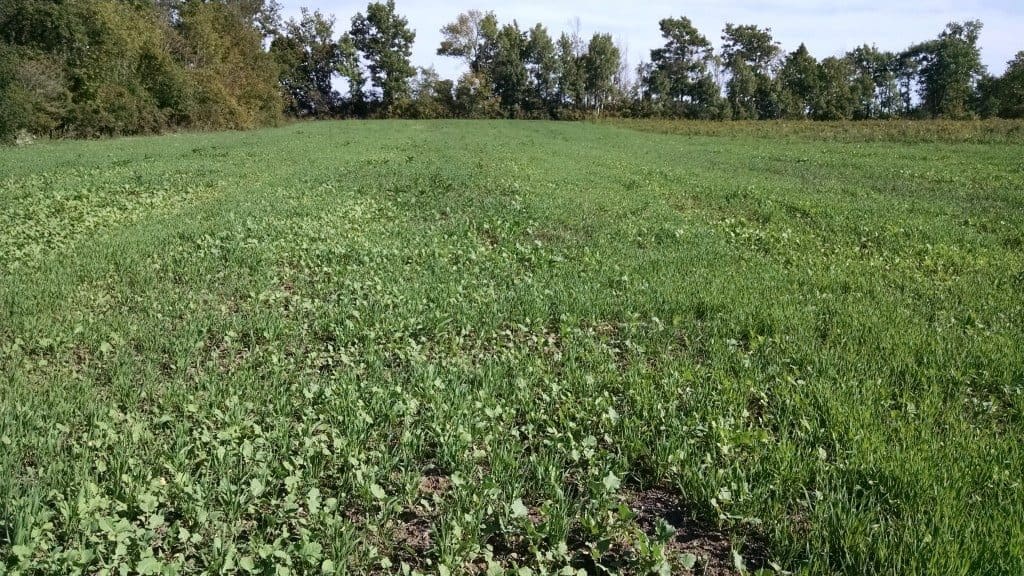Last week we turned the cattle in to the pasture where I seeded millet in July. For reference you might also want to read Edmund Brown’s recent blog post as we both try to figure how to make this work on our Upstate NY grazing farms. I realize that this topic has limited interest, but I’ve got to keep harping on it because I’m convinced there are big dividends awaiting if we can figure out a way to grow annuals without over-investing in equipment and without diminishing our soil and water resources.
Last month I did a writeup describing the project as a failure, but interestingly about a week after I wrote it I noticed small millet shoots popping up all over the field. I’m going to revise my hypothesis to blame the failure on the design of the no till drill, and I’ll accept my share of the blame for being inexperienced with this piece of equipment. The long-delayed germination and subsequent inability to outgrow the perennial cool-season canopy was caused largely not properly slicing through the plant thatch.
The Haybuster drill has a set of double disc (or double coulter depending on who’s describing them) openers in front of the seed drop tubes and press wheels. Other drills have a better design: a single coulter in front to cut through the stubble, followed by double disc openers, the drop tubes, and the press wheels. I think my problem was that because I focused on getting a shallow planting depth (1/4″-1/2″ depth), I wasn’t able to get enough slicing action from the openers. The leading coulter design used by other manufacturers would allow for a deep cut through all the live plants and thatch, followed by a very shallow skimming pass with the openers. In retrospect, the Polyface video I referenced in my last post included a little side discussion by Daniel Salatin about the need for the extra coulter, but somehow I missed that the first time around.

I don’t think I could justify the purchase cost outright, and I certainly don’t have that money in my pocket right now, so I’m going to have to (1) quit trying, (2) figure out a way to make the Haybuster drill work, or (3) find some other rental drill. Obviously #3 is the my preferred choice, so I’ve started looking around. Healthy perennial pastures are always going to be the backbone of our grassfed beef system, but I think the wise use of no-till practices and annual crops can increase our forage production, improve our soil biology, and strengthen our drought resiliency, all because more species of plants will be active for a greater portion of the year.
Good news for other annuals: the oats and rape planting in the pig pasture is doing well. I think the cultipacker was critical to boosting germination beyond what I’ve seen before. If my four wheeler had been working at the time I could have used my broadcaster to get more consistent coverage, but I think the results are great considering the kids were helping me broadcast the seed by hand, so there was extra chaos in the process. After all the planting failures, when I pass by this field each day on my trip to feed the pigs whey, I get a deep sense of satisfaction looking at how well the oats are growing. As of today they are up to the middle of my calf, so I expect them to be knee high or better when the cattle are turned in.

Finally, here is another pasture cropping video, this time from Greg Judy. He’s making it work in a hard drought and only grazing the pasture down to six inches. A big difference is that he’s working with Kentucky 31 Fescue, a grass we don’t deal with much around here (for better and for worse).

3 thoughts on “More on Annual Forages”
I’m not sure if any of my experience will be applicable to your farm, but I farm in Oklahoma, and I’ve been experimenting with pasture cropping wheat for about 4-5 years, and I’ve grown millet, sorghum-sudangrass, grain sorghum, and mixes of all of the above on my cropland.
All my pastures are warm season grasses, native prairie grasses like big bluestem, little bluestem, indian grass, etc, and introduced grasses like bermudagrass.
When I started pasture cropping wheat, I used a conventional drill which seemed to work if there was enough soil moisture and I slowed down, but a no-till drill worked much better.
I usually tried to bale the field, I’d wait till early fall when the grass would start going into winter dormancy, then I’d graze it right before drilling the wheat, but my best results came a couple of years ago when I grazed the pasture for a few days AFTER I had drilled the wheat instead of grazing it before it was drilled. I was able to get some grazing over the winter, topdressed it with a little nitrogen in the spring, and ran the combine over it in June.
I’ve grown millet in both a conventionally tilled field and no-tilled into wheat stubble, and I had a tough time getting a decent stand after no-tilling it. At the time, I thought it might have been something to do about the small size of the seed, my planting depth, and running out of moisture. If I planted it too shallow, it would get too dry before it germinated, and if I planted it deeper into moisture, it would be too deep to emerge.
An old rule of thumb that I’ve heard is that millet grows best in sandier soils, and sorghum-sudangrass grows better in heavier clay type soils.
My best millet growth was one year when i threw all my leftover millet, sorghum-sudangrass, and grain sorghum into the drill and planted it as a mix. I theorized that the bigger sorghum seeds were able to break open a path for the millet seeds to emerge.
I’ve never tried it, but if I was trying to plant millet or sorghum-sudangrass into a perennial pasture, I think I’d plant a mix of about 10-15 lb. of millet with about 3-5 lb. of sorghum-sudangrass (a little goes a long way with sorghum-sudangrass). And, I’d think about planting with a wider row spacing (15″ instead of 7.5″, or even using a planter).
That’s a quick and dirty summary of my experience.
Thanks, that’s useful info.
We’re dealing with cool season grasses and we normally have such short summers that I know I’m really pushing it in this climate because we don’t have a severe summer dormant period. I’ve got a little left over millet seed to dump in the drill next year, but I’m going to try again with sorghum-sudangrass. And I’m also thinking that winter wheat (or winter triticale which seems to be more popular around here) might be a better bet for no tilling into perennial pasture.
What’s the rationale for the wider row spacing?
Thanks again for your input.
I might be mistaken, but in a lot of the pasture cropping and no-kill cropping info that From what I’ve read online, it seems like most of the Australians are using drills with openers spaced about 10-12 in. apart. It’s never explained why that is or if it’s an important part of the whole process, but it’s something that I’ve noticed.
If the seeding rate per acre stays the same, a wider row spacing would mean that the distance between seeds (and plants) would be much closer within the row, which might make it easier for whatever is planted to germinate and emerge in the thicker sod type of soil conditions of a perennial grass pasture.
If I was planting a warm-season plant like sorghum-sudangrass, the same sort of idea would apply, plus with a wider row spacing there would be less chance of negatively impacting the cool season grasses by shading or smothering.
Besides all that, there’s a youtube video (https://www.youtube.com/watch?v=Fd-iRHYy7A8) about some research into warm-season annuals that suggests that you can get the same amount of forage production planting lower rates of sorghum-sudangrass at much wider row spacings (~5-10 lb. on 36 in. rows). Planting into a perennial grass stand, I’d think you’d have the same advantages, plus your planting expenses would be less.
A little 4-row planter with a set of row cleaners might be the perfect pasture cropping setup for a small farm. It might even be possible to get creative and use something like that to plant small grains (make two perpendicular passes, or try to split the rows).